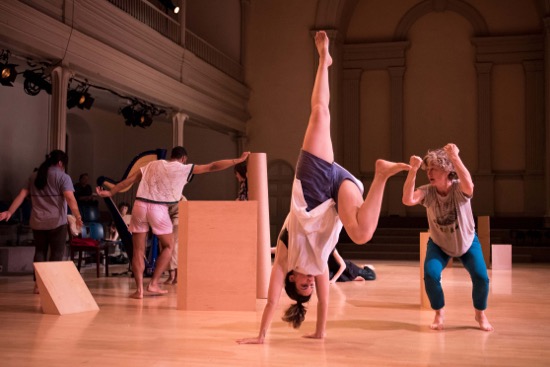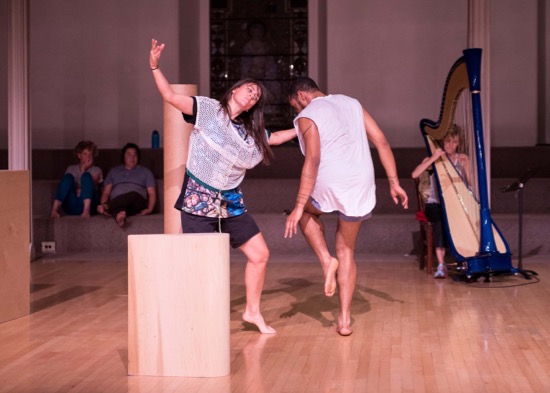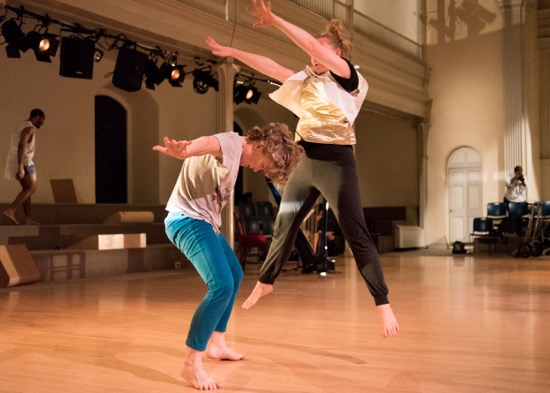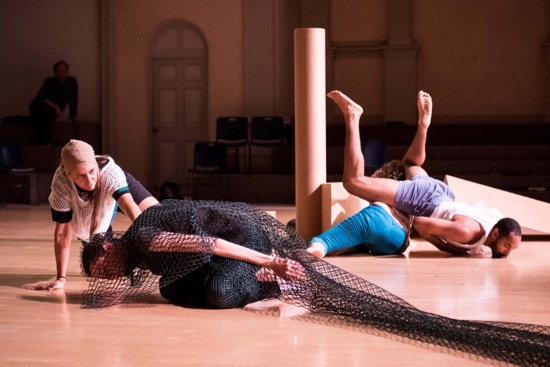Jennifer Monson/iLAND performs in tow in St. Mark’s Church.

Photographed in dress rehearsal: Jennifer Monson’s/iLAND’s in tow at Danspace Project. Visible (L to R): Valerie Oliveiro, Niall Jones, nibla pastrana santiago, and Jennifer Monson. Photo: Ian Douglas/Courtesy Danspace Project
Improvised dance performances, however they are structured, have something in common. Performers keep a sharp eye out for one another, whether they’re moved to join a comrade, pursue a solitary investigation, instigate a change, or draw on some prearranged material. Sitting in St. Mark’s Church watching Danspace Project’s presentation of Jennifer Monson’s in tow reminds me, viscerally, of what it was like to be part of such an endeavor. You could get pleasantly involved with another performer or, sensing that the improv was heading into the doldrums, do something unexpected. You usually spent time holding still and surveying the field in order to figure out how you might fit in. Master improvisers, like those in the Grand Union of the 1970s, had a rule about not abandoning a strategy until it had been milked dry; others more fickle jumped around trying new strategies.
Unlike the members of the Grand Union (in its heyday, David Gordon, Steve Paxton, Trisha Brown, Douglas Dunn, Nancy Lewis, and Barbara Dilley), in tow performers don’t speak, so we experience purely visually the forces at work at work. The piece’s very title suggests how a performer may be pulled into someone else’s plans or orbit—whether by decision or irresistible attraction. The seating arrangement makes a statement in keeping with this; the audience is banked in two diagonally opposite corners of the space. Since 2000, Monson has explored migration patterns of birds and whale and the effects of environmental change on human and animal life. It’s no surprise that her program note explains that the seating arrangement is “the residue of our experiments with horizon. It suggests the two sides of the firmament.”

DD Dorvillier, Niall Jones, and Zeena Parkins in in tow. Photo: Ian Douglas/Courtesy Danspace Project
The eight improvisers (Susan Becker, DD Dorvillier, Niall Jones, Alice MacDonald, Valerie Oliveiro, nibla pastrana santiago, Angie Pittman, and Monson) are accompanied intermittently by master composer/harpist Zeena Parkins, or by members of the TILT Brass Ensemble (Tim Leopold, Mike Garfield, Jen Baker, and Will Lang). Half the spectators may see the two trombonists on one side of the church’s u-shaped balcony, but only hear the two trumpeters opposite those, while the rest of the audience has the reverse experience. They not only emit those powerful tones; at times, the musicians breathe into them. Theirs are not the only sounds. (Whose feet suddenly hit the floor behind us?) The last thing we hear are the chime of small bells rung by Monson and Oliveiro as they stand face to face.
The nave and carpeted risers could be considered a playground for wily adults. Parkins’s harp and two other sound stations edge the main performing area, and two cardboard columns and several wooden wedges (by Joseph Silovsky) stand about in it. A rack full of clothes sits on a riser, and a two-dimensional arrangement of slim black tubing hangs, snaking and curling on the wall that backs the altar.
A passing thought: What would an observer unfamiliar with dance or defining it primarily as ballet think of this hour-long zone of activity? in tow doesn’t tell us what to focus on, it provides small climaxes (some of which may differ from viewer to viewer), it doesn’t seem to “go anywhere” (although we can tell when it’s winding down). One pressure that I do feel comes from looking at that gleaming blue harp near where I sit and wondering when Parkins is going to come and play it.

Jennifer Monson (L) and Alice MacDonald in in tow. Photo: Ian Douglas/Courtesy Danspace Project
The diverse performers are not show-offs, and virtuosity is underplayed. My eyes wander around, then are caught by something flickering off to the side. Or I follow someone’s task of drawing some black tape down the steps and using it to create a track across the floor. I note the moment when MacDonald copies Dorvillier, who’s holding her arms in a particular position (one straight forward, one bent, as if drawing a bow) while leaping toward a corner. I fix my gaze on Monson, as her initial passages of fast, springy, small-scale footwork leads her now to this person, now to these two, like a hostess making sure everyone’s having a good time. I contrast Becker’s tautness with pastrana santiago’s muscular fluidity with Oliveira’s solid power. I watch Pittman, especially when she’s dancing alone on a riser to my left, relishing her choices and the modulations that shape her movements. Jones is so vigorous that you’d be wary of getting close to him; amazing the way he swings his legs around, or locks them temporarily together in some crazy way.
Parkins’s arrival at the harp draws them together. After she has plucked a rippling musical tumult out of the instrument and settled into a repetitive melody, they gather around her, laying out objects at her feet: wrinkled lengths of paper, the green fishnet garments they’ve been wearing over their bright, mildly zany everyday outfits, and items of clothing from the rack. At some point, MacDonald is buried in the stuff. In addition, the rack tips, spilling hangers before Becker catches it. Dorvillier carefully drapes a long blue garment over Parkins’s shoulders and carefully postions a bizarre headdress. Parkins, virtuoso that she is, doesn’t miss a note and walks, trailing the blue fabric, to another of her stations, where she play a small triangular harp on a stand (to my ears, it can sound almost like a guitar, also growl like an I-don’t-know-what).

Jennifer Monson/iLAND’s in tow. (L to R): DD Dorvillier, Susan Becker, Monson, and Niall Jones. Photo: Ian Douglas/Courtesy Danspace Project
For a moment now and then during in tow, I wonder—as I sometimes do—what a person from a much earlier century would make of the goings-on. The gutsy, buoyant movements, the rolling on the floor, and the number of manipulable objects might make him/her see these agile, inventive people as having the spontaneous vigor of children at school recess—taking up with this person, joining that activity, spying something yonder that interests them. Or, if I think back far enough into history, as a community of the mildly, charmingly insane. We know better, of course. These are mature, gifted, well-educated artists, whose “behavior” is constrained only by the rules that Monson has set, and by their desire to explore—considerately and often wittily—what it means to be alone and what aspects of togetherness bind them.
I regret very much not being able to get to St. Mark’s during the 6-7 P.M. “Pre-Attack” for in tow, the purpose of which was to “give the audience an opportunity to experience some of the underlying infrastructure of the work.” What I did see was an urban environment where all manner of entanglements—willed or accidental—can take place, and where one’s horizon is often the building across the street.
